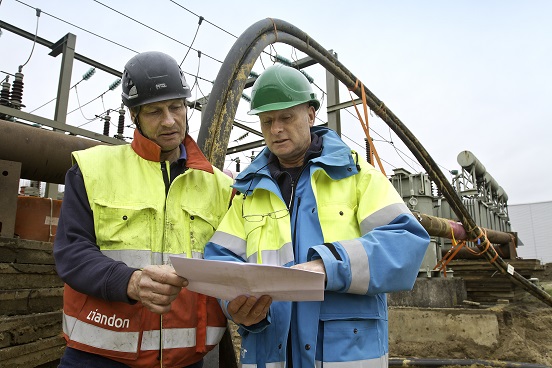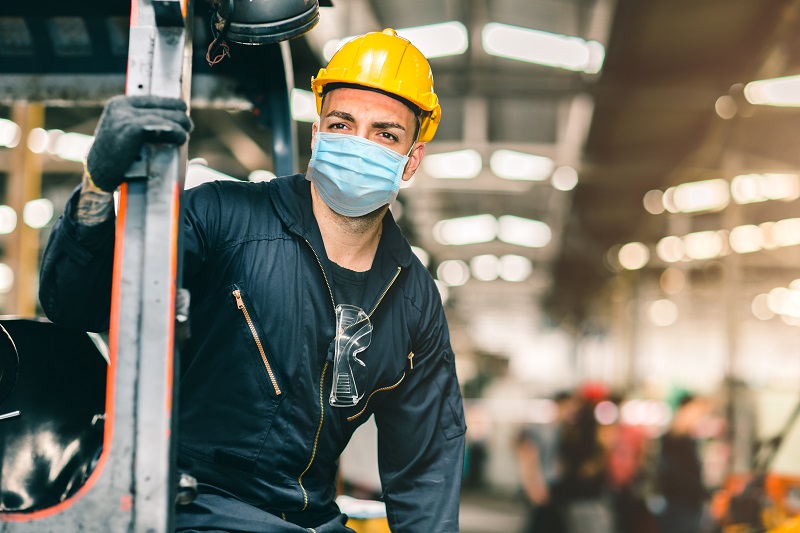The so-called new society is a hot topic in the Netherlands. Every organization has to guarantee a one and a half meter distance for both their personnel and visitors. These new rules also apply to industrial players, resulting in for example the postponement of planned maintenance stops at some refineries. A decision with a significant financial consequence.
Author: Rick Snippe
As a reason, it is suggested that health and safety cannot be guaranteed if there is considerably more personnel on site. In a normal operation there may be dozens of personnel present, but in the event of an incidental shutdown or planned large-scale maintenance, this number can skyrocket to thousands of specialists and (sub)contractors.
It is understandable that due to various government regulations and strict safety measures, companies choose to postpone planned maintenance. However, is that really the best option on the table? Alternatively, are there technical and organizational possibilities to have maintenance take place in a one and half meter society?
Currently, a number of production facilities are operating with less staff. However, if critical assets fail, this undesired downtime can result in immense consequences for the entire business chain. Especially in these times, effective operation of the installation is essential. Production downtime can cost between thousands and millions of euros an hour. For this reason, performing large-scale maintenance on time is still the best protection layer.
In addition, we see that now, in time of COVID-19, production is being reduced in the oil and gas industry. Consequently, we can conclude that, from an economic point of view, it is crucial to carry out maintenance right now. Because, when society returns to full production and when COVID-19 is mitigated, the installations running at maximum efficiency will have a competitive advantage. Moreover, the procrastination behavior of multiple organizations has made it considerably more complex to hire the best contractors when the restrictions are reduced. After all, many organizations want to carry out large-scale maintenance all at once.
This obviously results in scarcity on the market, which could lead to significantly higher operational costs. Therefore, it is worthwhile exploring the possibilities of achieving a safe and efficient maintenance stop in the current circumstances. In case the current one and a half meter society stays in place for months or years, the application of crowd management measures is a very strong method to realize a safe and reliable maintenance stop.
Preventing business downtime
To prevent production downtime in the long-term, it is particularly important to continue with preventive maintenance at this moment in time. By strategically using the current situation, this will ultimately result in a stronger comeback. Moreover, it is important to maintain the current value of the installation. Especially in times when certain assets are used less, it is essential to take good care of them. Additionally, periodic maintenance reduces safety risks and increases the reliability of the installation.
However, in order to carry out maintenance work in the new society, personnel need to know how health and safety risks of being together are mitigated to an acceptable level. My colleague Denise Harkema, HSE Management Consultant at Bilfinger Tebodin, has published a very extensive blog post on this subject, which can be found here. Nevertheless, it concerns a large group of people in a limited area. In order to organize a safe maintenance stop, it is necessary to keep sufficient distance from each other. That said, several causes could lead to stagnation of personnel flows. For example, due to weather conditions, the effective work location, conflicting walking routes and so-called bottlenecks at corridors. Furthermore, the number of personnel on location can be so high that the volume in relation to the available workspace is simply too large.
In order to realize all the above in today’s situation and thus achieve an effective and efficient large-scale maintenance stop, monitoring personnel flows is necessary. The plant management must also realize that safety is not a set of rules or conditions, but rather a set of norms and values. A positive attitude of the management is therefore key to an effective maintenance stop during the time of COVID-19.
Crowd management phases during a large-scale maintenance stop
Each industrial plant is unique and therefore requires ongoing customization. It also requires extra attention from the senior and operational management team. After all, they have to deal with managing the movements of the personnel. Before they can do so, they have to understand the operation, the plant, the layouts, the workers and the theory. Understanding your personnel effectively is in fact the first step in a safe large-scale maintenance stop. The planning has to be adapted to this.
However, not everything can be planned in advance. There are also so-called catalysts, which can lead to people no longer keeping the desired distance from each other. This can be due to weather factors, operational circumstances, or actions of an individual. The safety team has to make sure that if there is a catalyst, one returns to the level that has been prepared as soon as possible.

After an analysis of the movement patterns of an employee, we can conclude that a safe distance maintenance stop, with a significant number of personnel, should consist of the following six main phases:
1. Preparation, preparation, preparation
The management team must consider executing the work with as little staff on site as possible. In order to achieve this, it is wise to prioritize maintenance components. A question can then be raised whether it is possible to perform the maintenance in smaller phases. Additionally, it is useful to discuss if a longer turnaround time is possible. If the number of personnel is reduced, it will be easier to respect the one and half meter society and therefore simplifies the next steps.
2. Staff arrival
The maintenance stop in the one and half meter society already starts outside the borders of the industrial plant. Although it is not always possible, guiding personnel as early as possible offers various advantages. Depending on the number of personnel and the location of the industrial plant, this can already start at the public transport stations and parking lots. From here on, the infrastructure must be such that multiple routes and entrances are available in order to keep sufficient distance. The use of physical barriers and signage promotes safe distance. Moreover, one-directional paths need to be created to ensure that one does not walk in opposite directions towards each other, which will reduce general contact moments. Last but not least, it is important to give clear instructions to all staff, so that people with symptoms of illness do not enter the site at all. However, an extra barrier is needed here. For example, special rooms can be set up for screening personnel and suppliers. Nevertheless, it is obvious that this limits the flow rate and this must be taken into account so that the available free space remains sufficient.
3. Gate entry
During a large-scale maintenance stop, a high number of personnel have to be admitted to the industrial plant in a relatively short period. It is clear that this must be done in a structured and safe manner, in compliance with the applicable government guidelines. The management must therefore focus on the capacity, the arrival, the number of entrances, the maximum waiting time, the maximum row length and the number of people that can be checked and admitted per minute. Moreover, it is worth thinking about the introduction of various shifts, so that the peak load can be spread over several time slots. Additionally, the management has to consider which tasks can already be undertaken from distance, such as watching gate instruction videos. Implementation of technical and organizational measures is preferable to minimize queues. On the other hand, the entrance will always remain one of the bottlenecks. It is advisable to provide staff and visitors with personal protective equipment at an early stage, so that they have disinfectants and face masks available while waiting. This will be useful in the next phase as well.
4. The actual working activities
During the maintenance stop, the primary role of the safety team is to assess the condition and distances of the workers, evaluate the active scenarios, predict future scenarios and carry out the associated actions. These actions will focus on avoiding worker density at critical levels. Therefore, the focus should be on areas such as entrances, exits and the places where queues can arise like loading bays, toilets, smoking and catering areas. If possible, several routes and entrances should be opened to personnel, however, this depends on the infrastructure of the industrial plant.
It is worth exploring the use of intelligent equipment. Workers can be equipped with body cameras and GPS trackers. In this way high density locations can be prevented since personnel can be directed live to follow a route with the most available space. This real-time-maintenance-force monitoring can be seen as a digital map of the site with moving symbols. The symbols are the employees equipped with tracking devices. In this manner, it is possible to intervene from the control room, but it is also possible to make analyses. These analyses can then be used to reorganize the working activities for the coming hours and/or days, so that overcrowding can be prevented. In addition, there are maintenance companies that use so called smart glasses. In this way, supervising assistance is provided at a distance. By using these initiatives, the number of personnel on site is minimized while the work can continue.
During large-scale maintenance, there is often a central post where meetings are held. This is where decisions are made and schedules are adjusted. It is an option to transfer these meetings to an online platform as well. Nevertheless, communication is extremely important, both to exchange information within the safety team, but also to inform personnel of plan changes or actions to be carried out. Communication is the most powerful means of influencing the desired distance between personnel.
5. Outflow
An outflow time should be set, in which the one and a half meter distance is respected. The outflow time is therefore the total time during which all personnel can leave the industrial plant under normal circumstances. This time can be set to X-minutes. If, for whatever reason, the personnel cannot leave the industrial plant within these X-minutes, then there are simply not enough exits.
An inflow is relatively balanced, but an outflow can take on massive proportions. This means that the workers have to be spread out over various exits as much as possible. Another alternative is to introduce varying ending times, eliminating the massive outflow as well. To prevent bottlenecks, it is crucial that there are no conflicting flows between arriving and departing workers.
To refer back to real-time-maintenance-force monitoring, this can also be used during the outflow of personnel. For example, it is possible to work with a digital working permit. In this way, instructions can be received from a distance to stop working within X-minutes, to clean up the workplace safely and to leave towards exit Y. By doing so, a controlled outflow of personnel can take place.
6. Departure
Lastly, there is a departure of workers from the industrial plant back into the public domain. This includes all transport flows and movements at the parking lots and public transport locations. One should bear in mind that workers may have arrived in the daylight and perhaps leave when it is dark. Adequate signage and lighting is therefore necessary to prevent long searches for parked cars. This also ensures that personnel can continue to respect the one and a half meter society.
It is all about maximum efficiency
By focusing on crowd management, the management of an industrial plant can classify and prioritize hazards, risks and maintenance critical elements. Because the application of crowd management allows work to continue safely, this will ultimately prevent premature wear and tear or broken equipment. Besides that, loss of efficiency is avoided and periodical inspection moments can be met. Every organization has to think about continuous improvement and the “new normal”. All of the above is simply focused on facilitating and preparing, allowing distance problems to be proactively prevented or quickly resolved. Proper and effective execution is crucial for the success of a maintenance stop, with the main results being the safety of personnel and an optimal economically used production drop.




